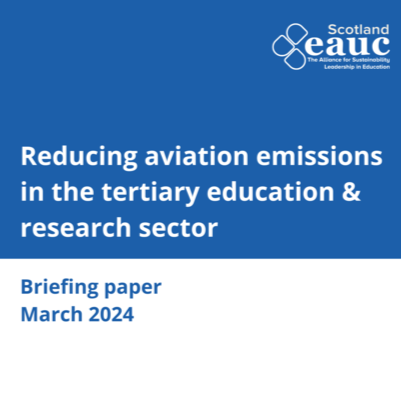Reducing aviation emissions in the tertiary education and research sector series: briefing paper
For the first instalment of our Reducing Aviation Emissions blog series, we have a briefing paper compiled by Lara Fahey and Matthew Woodthorpe at EAUC Scotland. This paper sets out the aviation decarbonisation challenge, current best practice, and present and future solutions to meet this part of the net zero challenge. Heavily referenced, readers are encouraged to delve further into the topics presented with a plethora of sector-specific resources at their fingertips.
This briefing paper:
Key points:
Download the Briefing Paper.
If you have any questions about this series, please get in touch.
This article is part of a series of blogs on reducing aviation emissions. Blogs will be released fortnightly to coincide with our newsletter. The full series will be available by the end of May 2024.
This briefing paper:
- Details the current aviation demand trends in the UK and draws on Scottish college and university emissions reporting data to Scottish Government;
- Summarises the main decarbonisation actions being taken by the aviation industry and draws on critiques of these within external publications;
- Summarises the main drivers of aviation travel within the sector;
- Details co-benefits associated with reduced aviation travel;
- Highlights the policy context for institutional aviation emission reduction and emissions reporting;
- Showcases institutional best practice and signposts to a range of further resources to support individuals and institutions to reduce aviation demand.
Key points:
- Aviation emissions dominate both national and institutional emissions profiles, with the vast majority of institutional business travel emissions (typically over 90%) deriving from aviation.
- The technological ‘fixes’ of aircraft technology, sustainable aviation fuel (SAF) and offsetting won’t go fast or far enough for institutions to meet their net zero targets by or before 2050.
- Some of the main sources of aviation emissions come from travel to conferences, international student emissions, international research and fieldwork.
- We need a cultural shift as a sector to reduce the demand for aviation and start to work in more innovative, increasingly digital ways.
- This shift will bring many opportunities to the sector: increased accessibility and inclusivity, financial savings, increased international collaboration opportunities outside of the western developed nations, and of course emissions savings.
- Institutional best practice case studies can be found from the University of Oxford, University of Edinburgh, University of Glasgow, University of Manchester and the University of Aberdeen. Learning from these institutions and taking forward their solutions will cause significant change across the sector.
- A selection of relevant resources, policy information and contact details are listed in this briefing paper to aid your institutional journey.
Download the Briefing Paper.
If you have any questions about this series, please get in touch.
This article is part of a series of blogs on reducing aviation emissions. Blogs will be released fortnightly to coincide with our newsletter. The full series will be available by the end of May 2024.











